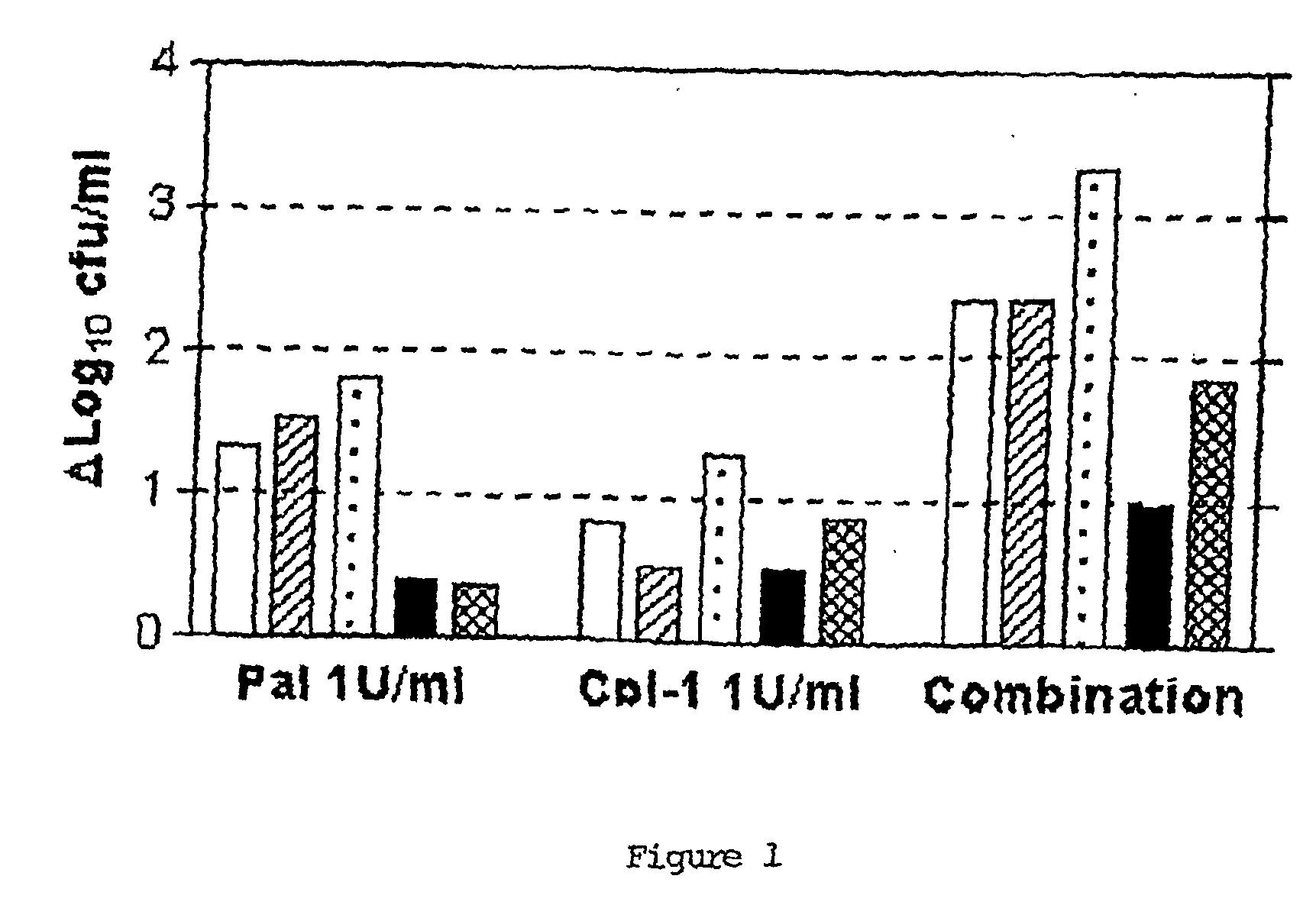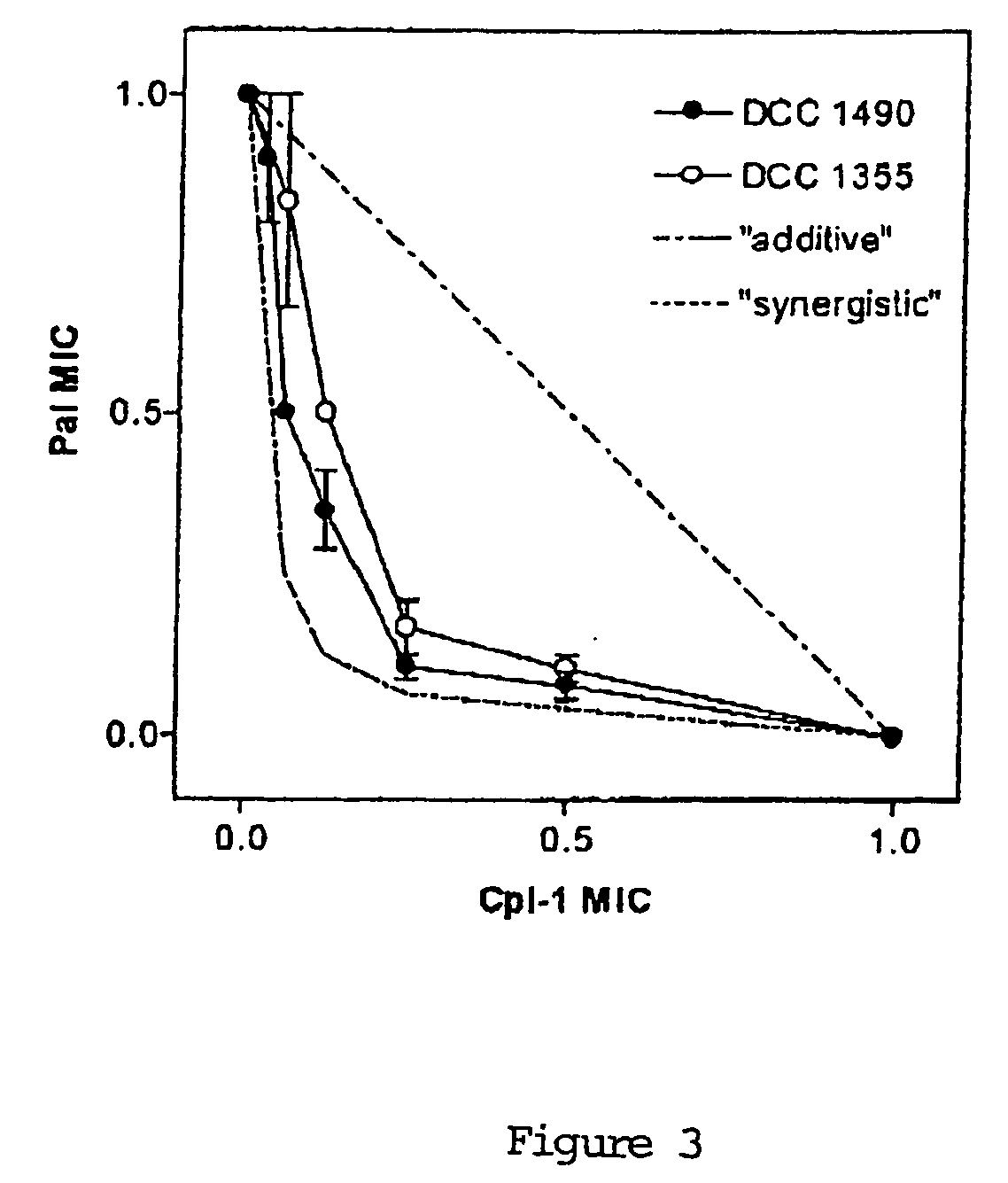Uses of sysnergistic bacteriophage lytic enzymes for prevention and treatment of bacterial infections
- Summary
- Abstract
- Description
- Claims
- Application Information
AI Technical Summary
Benefits of technology
Problems solved by technology
Method used
Image
Examples
example 1
Bacterial Strain and Culture
[0123]E. coli DH5α(pMSP11) expressing Pal and double-stranded DNA from the pneumococcal phage Cpl-1 were used in the present studies (Sheehan et al. 1997, Mol. Microbiol. 25(4): 717-725). The Cpl-1 expressing E. coli DH5t(pJML6) was constructed as follows: The Cpl-1 gene was amplified from Cpl-1 total phage DNA with a primer pair designed according to the published GenBank sequence number Z47794, flanked by XbaI and HindIII restriction sites, transcriptional start and stop codons, and a ribosomal binding site. To use the same powerful expression system as for Pal, which is based on the construct pIN-IIIA and contains a double promoter, we digested the plasmid pMSP11 with XbaI and HindIII, which removes the entire inserted Pal gene (Masui et al, 1984, Bio / Technology:81-85, Sheehan et al. 1997, Mol. Microbiol. 25(4): 717-725). The PCR product was subcloned to pMSP11 using the XbaI and HindIII recognition sites to produce the pJML6 construct. E. coli DH5a(p...
example 2
Time Kill Experiments-Short Exposure
[0125] Time-kill experiments were conducted with very short exposures, since the killing with both enzymes can be observed within seconds. Moreover, it is envisioned that a typical application of compositions containing a combination of both enzymes in the nasopharynx would be unique and short. Mid-log-phase cultures of S. pneumoniae strains DCC 1355, DCC 1490, DCC 1494, DCC 1335, and DCC 1420, (serotypes 19, 14, 14, 9V, 23F and, the latter 3 highly penicillin-resistant) were pelleted and resuspended to an absorbance at 600 nm of 1.0 (approximately 109 CFU / ml). 150 μl of Pal or Cpl-1 at a final concentration of 1 U / ml, or a mixture of both at a concentration of 0.5 U / ml each was added to 150 μl of the bacterial solution. Colony counts were performed after 30 seconds and 10 minutes and compared to a control exposed to enzyme buffer only, by serially diluting a 10 μl aliquot in saline and plating on 5% Columbia blood agar (CBA), with a detection li...
example 3
Time Kill Experiments-Long Exposure
[0127] Time-kill studies with longer exposure (up to 19 h) were performed using only strains DCC 1355 and DCC 1494. Bacteria were grown in cation-adjusted Müller-Hinton broth (CAMHB) with 2.5% lysed horse blood to mid-log-phase and resuspended in fresh medium at a titer of 1×107 CFU / ml. Pal, Cpl-1 or a combination of both were added at 0.25 MIC (12.5 U / ml of Pal and Cpl-1 for strain DCC 1355, 12.5 U / ml of Pal and 6.25 U / ml of Cpl-1 for strain DCC 1494). Samples were taken at 0, 4, 8 and 19 hours, serially diluted and plated on CBA for titer determination, with a detection limit of 100 CFU / ml. The usual definition of a titer reduction of the combination ≧2 log10 greater than that of the single most active agent was used for determination of synergy. FIG. 2 illustrates the results, which show synergy for both strains.
PUM
 Login to View More
Login to View More Abstract
Description
Claims
Application Information
 Login to View More
Login to View More - R&D
- Intellectual Property
- Life Sciences
- Materials
- Tech Scout
- Unparalleled Data Quality
- Higher Quality Content
- 60% Fewer Hallucinations
Browse by: Latest US Patents, China's latest patents, Technical Efficacy Thesaurus, Application Domain, Technology Topic, Popular Technical Reports.
© 2025 PatSnap. All rights reserved.Legal|Privacy policy|Modern Slavery Act Transparency Statement|Sitemap|About US| Contact US: help@patsnap.com



